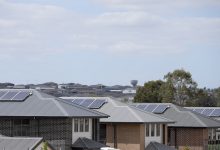Australia is on track to add a stunning 6.3GW of new renewable energy capacity in 2020, thanks largely to a rooftop solar market that has defied the odds of the Covid-19 pandemic and is headed to a record total of just under 3GW for the year.
According to the June 2020 Quarterly Carbon Market Report published by the Clean Energy Regulator on Thursday, renewable investment in both small and large scale renewables has exceeded expectations and punched above its weight for the Australian economy.
Clean Energy Regulator chair David Parker said that large-scale renewables were on track to deliver around 3.4 GW in new generation capacity for the year, while rooftop solar was likely to exceed the CER’s previous estimate of 2.7GW in 2020 and hit a total of 2.9GW.

An estimated 677MW of rooftop PV was installed in Quarter 2 2020, an 11 per cent increase on Quarter 1 2020 and 41 per cent higher than Quarter 2 2019, with the average system size rising to 8.2kW, up from 7.6kW in Quarter 1 2020.
“Strong growth in installations in the first half of 2020, coupled with a step change in system sizes and negligible Covid-19 impact means that the outlook for [small-scale technology certificate (STC)] supply remains strong and the STC clearing house will stay in surplus for the remainder of 2020,” the report says.
If mid-scale rooftop solar installations in the Large-scale Renewable Energy Target (LRET) (100 kilowatts to 5 MW) are included in the total, then rooftop solar would almost certainly sail past the 3GW mark for 2020, the CER said.
“This is a tremendous result considering Covid-19 impacts,” Parker said in comments on Thursday. “Last year’s record was just under 2.2 gigawatts.”
Parker noted that the strong growth in rooftop solar PV over the first six months of the year had also added an estimated 2,800 jobs, at a time when employment in other sectors has contracted.
But the CER report also acknowledges the flip-side of this extraordinary small-scale PV growth, with a spotlight on the impact it was threatening to have on grid stability.
“With rooftop solar PV capacity up 41 per cent year on year, the key question is whether changes to distribution networks, DER technical standards and other rule changes can occur quickly enough to accommodate ongoing record increases in rooftop solar PV,” it says.
The report notes that the CER’s 2018 RET Administrative Report identified the development of renewable energy integration strategies as the next key phase in the transition to a clean energy future.
“Action is underway by AEMO, industry bodies, governments and distribution network service providers (DNSPs) alike to manage increasing penetration of distributed and variable energy generation,” the report says.
“Agencies such as the Australian Renewable Energy Agency… and the Clean Energy Finance Corporation have also shifted their funding priorities in 2020 to focus on system strength and grid reliability.”

And the report points to residential and community battery storage as well as adjustments to inverter standards as key potential resources of grid stability.
In a separate analysis of the new CER data from the Australian National University, also highlighted this issue.
“While (the latest data) is good news, we urgently need more investment to remove bottlenecks in deployment of further renewables,” said the ANU paper’s co-author and leading solar innovator, Professor Andrew Blakers.
“An effective way to do this is to upgrade transmission lines from rural Renewable Energy Zones, such as those recently announced in NSW and Queensland, to our cities.”
But transmission bottlenecks aside, Blakers welcomed Australia’s continued global leadership in renewable energy uptake, with a total of 18GW installed between 2018 and 2020.
“For comparison, this much new solar and wind will generate twice as much electricity as gas power stations currently generate in the National Electricity Market,” he said.
ANU report co-author Matthew Stocks said that the strong growth in solar installations was helping to drive increased uptake in an Australian invention, the PERC solar cell design developed by the University of New South Wales.
“Indeed, PERC solar modules are being deployed faster than the net new generation capacity of coal, oil, gas and nuclear combined,” Associate Professor Matthew Stocks added.
“Australia is also demonstrating that rapid deployment of solar and wind can lead to declining emissions and low electricity prices,” he said.
More stats of note from the CER Quarterly Carbon Market Report, June Quarter 2020:
– The CER accredited more than 2GW capacity of large-scale renewable projects during the first half of 2020;
– The large-scale renewable energy market is experiencing substantial real investment, delivering around 2-3GW of capacity each year – six times the average capacity in the years prior to 2017.
– There were 2,250 concurrent battery storage systems installed in Quarter 2 2020, similar to the 2232 batteries installed in Quarter 2 2019. The increase in the quarter was modest, however, a threefold increase was observed in the 7.5-8 kW 10.5-11 kW and 13-13.5 kW system ranges compared to Quarter 2 2019, albeit off a low base.










